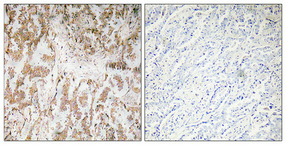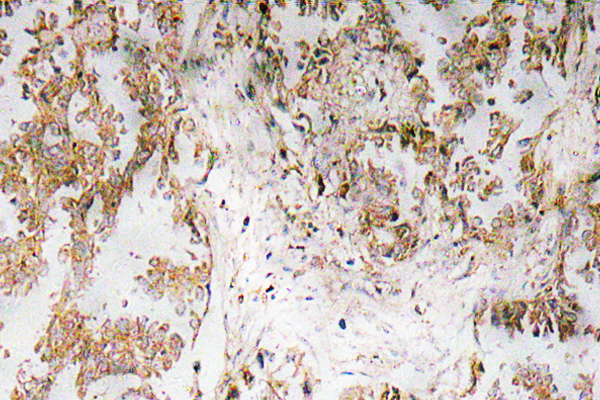IL-1α Polyclonal Antibody
- 货号:YT2321
- 应用:IHC;IF;ELISA
- 种属:Human;Mouse;Rat
- 简介:
- >>MAPK signaling pathway;>>Cytokine-cytokine receptor interaction;>>Necroptosis;>>Cellular senescence;>>Osteoclast differentiation;>>Hematopoietic cell lineage;>>Non-alcoholic fatty liver disease;>>AGE-RAGE signaling pathway in diabetic complications;>>Type I diabetes mellitus;>>Alzheimer disease;>>Prion disease;>>Pathways of neurodegeneration - multiple diseases;>>Pertussis;>>Leishmaniasis;>>Tuberculosis;>>Measles;>>Influenza A;>>Inflammatory bowel disease;>>Rheumatoid arthritis;>>Graft-versus-host disease;>>Fluid shear stress and atherosclerosis
- 蛋白名称:
- Interleukin-1 alpha
- 免疫原:
- The antiserum was produced against synthesized peptide derived from human IL-1alpha. AA range:8-57
- 特异性:
- IL-1α Polyclonal Antibody detects endogenous levels of IL-1α protein.
- 组成:
- Liquid in PBS containing 50% glycerol, 0.5% BSA and 0.02% sodium azide.
- 来源:
- Polyclonal, Rabbit,IgG
- 稀释:
- IHC 1:100 - 1:300. ELISA: 1:10000.. IF 1:50-200
- 纯化工艺:
- The antibody was affinity-purified from rabbit antiserum by affinity-chromatography using epitope-specific immunogen.
- 储存:
- -15°C to -25°C/1 year(Do not lower than -25°C)
- 其他名称:
- IL1A;IL1F1;Interleukin-1 alpha;IL-1 alpha;Hematopoietin-1
- 背景:
- The protein encoded by this gene is a member of the interleukin 1 cytokine family. This cytokine is a pleiotropic cytokine involved in various immune responses, inflammatory processes, and hematopoiesis. This cytokine is produced by monocytes and macrophages as a proprotein, which is proteolytically processed and released in response to cell injury, and thus induces apoptosis. This gene and eight other interleukin 1 family genes form a cytokine gene cluster on chromosome 2. It has been suggested that the polymorphism of these genes is associated with rheumatoid arthritis and Alzheimer's disease. [provided by RefSeq, Jul 2008],
- 功能:
- domain:The similarity among the IL-1 precursors suggests that the amino ends of these proteins serve some as yet undefined function.,function:Produced by activated macrophages, IL-1 stimulates thymocyte proliferation by inducing IL-2 release, B-cell maturation and proliferation, and fibroblast growth factor activity. IL-1 proteins are involved in the inflammatory response, being identified as endogenous pyrogens, and are reported to stimulate the release of prostaglandin and collagenase from synovial cells.,online information:Interleukin-1 entry,online information:The Singapore human mutation and polymorphism database,similarity:Belongs to the IL-1 family.,subcellular location:The lack of a specific hydrophobic segment in the precursor sequence suggests that IL-1 is released by damaged cells or is secreted by a mechanism differing from that used for other secretory proteins.,subunit:Mono
- 细胞定位:
- Cytoplasm . Secreted . The lack of a specific hydrophobic segment in the precursor sequence suggests that IL-1 is released by damaged cells or is secreted by a mechanism differing from that used for other secretory proteins. The secretion is dependent on protein unfolding and facilitated by the cargo receptor TMED10; it results in protein translocation from the cytoplasm into the ERGIC (endoplasmic reticulum-Golgi intermediate compartment) followed by vesicle entry and secretion (PubMed:32272059). .

- Immunohistochemical analysis of paraffin-embedded Human lung cancer. Antibody was diluted at 1:100(4° overnight). High-pressure and temperature Tris-EDTA,pH8.0 was used for antigen retrieval. Negetive contrl (right) obtaned from antibody was pre-absorbed by immunogen peptide.

- Immunohistochemistry analysis of IL-1α antibody in paraffin-embedded human lung carcinoma tissue.





